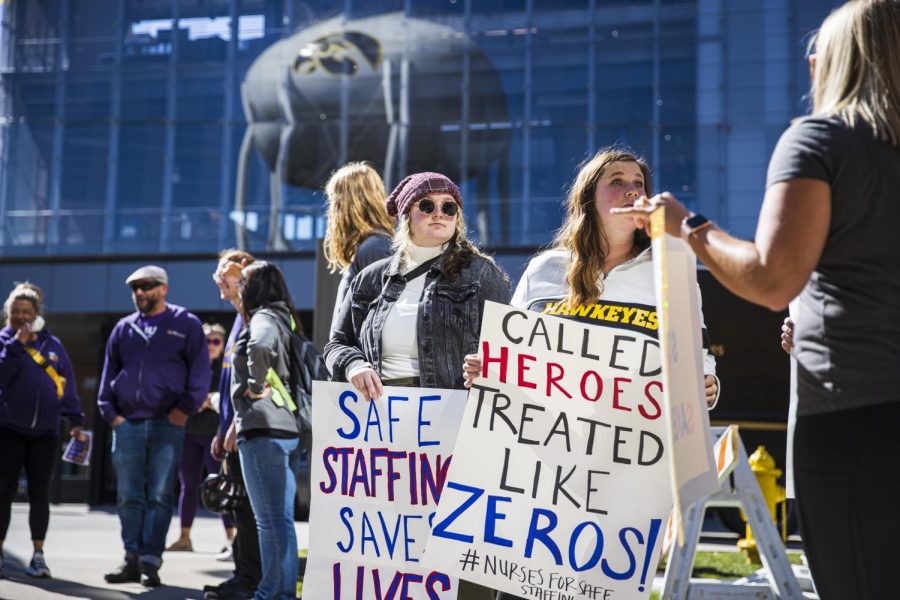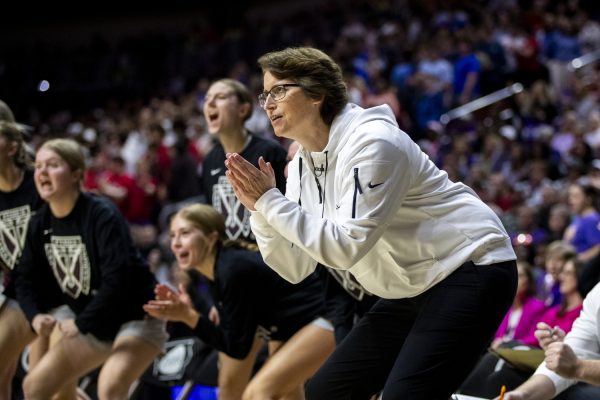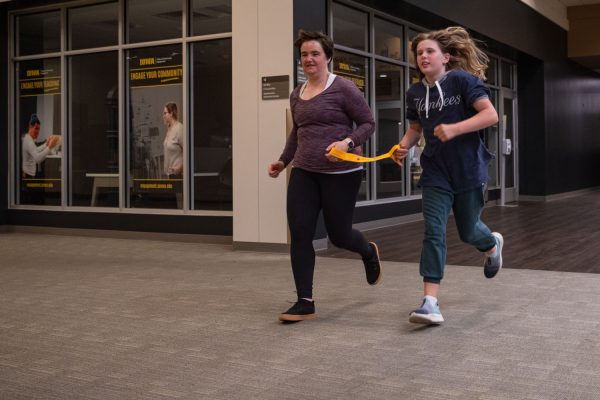UIHC nurses protest patient-to-nurse ratios, concerned with quality of patient care
Nurses gathered outside the UI Hospitals and Clinics general hospital on Sept. 29 to express concerns about quality of patient care amid staffing shortages.
Protesters communicate with each other during a protest for nurse to patient ratios on Hawkins Drive outside the University of Iowa Hospital and Clinic in Iowa City on Thursday, Sept. 29, 2022. About 20 protesters gathered to express concern over rising ratios.
September 30, 2022
University of Iowa Hospitals and Clinics nurses are asking for improved nurse-to-patient ratios to better the quality of patient care at facilities.
Across the country, nurses are quitting their jobs, largely due to burnout and feeling overwhelmed. UIHC also has openings, with an estimated 350 jobs currently unfilled in nursing at the hospital.
A group of nurses protested the issue outside the hospital on Sept. 29.
Ashley Lynn, a UIHC cardiac unit nurse, said nurses in UIHC care for three to four patients a day, but the number is about to go up.
“When I first started here, it was three per nurse, which was sometimes up to four, but that was okay. And now we’re like, pretty normalized. Everybody has four. And then now they’re telling us that we’re going to have to take a fifth patient,” she said.
Lynn said nurses are not able to provide patients with the quality of care they deserve when they have too many patients in their caseload.
“This was organized because we all really care about the quality of care that we give to our patients, and we don’t want our patients to be affected by the poor planning of the administrators, not staffing us correctly,” she said.
Grace Loomis, a UIHC nurse in the intensity and special services unit, said caring for a surplus of patients takes a toll on her mental health because she feels like she can’t adequately care for all her patients.
“You just want to do everything you can for these patients,” Loomis said. “You think of them as your own, like you treat them as you would the care you would for your family. And when you’re not able to do that, you just go home feeling guilty. It’s kind of just like, ‘Hi, here’s your meds, gotta go.’”
Loomis said the ratio of nurses to patients is also a risk for patient safety. When they are overloaded with patients, they can’t respond efficiently to concerns.
“How are we supposed to respond to our patients or fall risks? Or, when we don’t have the staff on the floor, to hear the bed alarms, to hear the PMU alarms, to respond to the alarms that are supposed to be in place to keep our patients safe,” she said.
Loomis said the solution to the overwhelming patient-to-nurse ratio is to put a cap on how many patients a nurse can take on in a day.
“I like the idea of having a mandate on safe staffing ratios. I know like California has laws against it that you were only allowed this many patients because quality care comes from safe staffing,” she said.
In an email statement to The Daily Iowan, Laura Shoemaker, a UIHC spokesperson wrote that the number of travel nurse contracts has stayed consistent at UI Health Care.
“The number of travel nurses who accept those roles may vary from month to month. Traveler rates vary based on supply and demand and prevailing market rates, and we continue to pay contractual rates that are competitive in the market,” she wrote. “Hospital staffing needs can change quickly based on the number of patients and their level of acuity [severity of illness]. Travel nurses are another strategy used to supplement regular workforce – not only to fill open roles, but to support staff.”
Jerod Ringwald contributed to this DI article.














